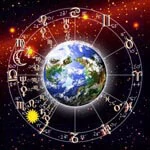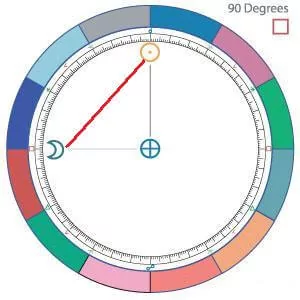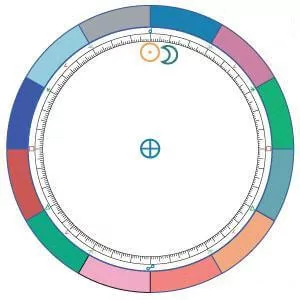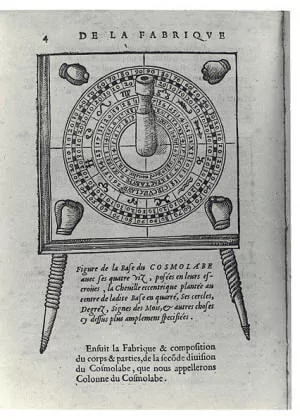Aspects in astrology are extremely important when interpreting any chart. Aspects indicate how the various planetary and sign energies actually play out. They indicate, among other things, if there will be struggles or ease. Without acknowledging the aspects in a chart, the reading is incomplete, and ultimately incorrect. Keep this in mind when you begin to read the interpretations of your planets in the signs of your chart – the aspects tell more of the story.
So, what are aspects in astrology? Simply put, aspects are a connection or relationship between two or more planets. This connection always alters the interpretation of the planets and signs involved. When planets are in aspect to each other, their interpretations must be blended according to the nature of the aspect.
To be precise, aspects are special degrees of separation between the planets, with respect to the Earth. Since astrology focuses on the interplay between the celestial bodies and our Earth, we take a geocentric (Earth-centered) view of the heavens. The planets, then, are observed to orbit at different speeds in approximately the same plane in space.

As a result of these planetary motions, various angles, measured in degrees, arc minutes, and arc seconds, are formed between the planets as seen from the Earth. In mathematics, an angle is defined as that fraction of a circle formed between two lines that intersect at the vertex. Imagine the Earth being at the center of the circle. Then imagine a line being drawn from two planets each to the Earth, so that the Earth is the vertex of the angle. The number of degrees between the two lines connecting two planets with respect to the Earth forms the angular relationship – the aspect – between the two planets. Aspects are considered not only for the planets, Sun, and Moon, but also for the points of the Ascendant and the Midheaven.
Example of an Aspect

In this example image, the Sun and the Moon are in "square" aspect. They are 90° apart, as you can see by the angle formed by the gray lines. However, astrologers do not label aspects like that, for that would be a tangled mess of lines in the birth chart. Instead, the angular relationships are denoted by a single line connecting the two planets in aspect. Thus, in any astrology chart, the square aspect will be denoted by a line like the red one in the image above.

Certain degrees of angularity are very important in astrology. They are called the "major aspects." The major aspects are 0° (conjunction), 60° (sextile), 90° (square), 120° (trine), and 180° (opposition).
What Are Orbs?
Now, aspects are given a margin in which they have an influence. For example, although the square aspect is 90°, two planets that are 95° (or 85°) apart are still considered to be in square aspect. This margin of influence is called an "orb" in astrology. In the example of 95°, it is considered a square aspect with an orb of 5°, since it deviates 5° from an exact square. An allowable orb is the amount by which the two planets involved can deviate from the exact number of degrees of the aspect and still be considered to have an aspect influence. Most astrologers use an allowable orb of only 6° for the major aspects, and 2° or 3° for the minor aspects. However, the allowable orb is increased to 10° (or 8°) if it includes the Sun or Moon. This is a matter of preference, but in fact, the smaller the orb, the more significant the aspect is, with orbs of less than 1° being the most potent aspect influences.
As you'll see below, each aspect can be defined as a circle divided by a number. A full circle is 360°. However, to avoid confusion, notice that the astrology chart is divided into 12 signs of 30° each. Then the square aspect (90°) will be between planets that are in the same degree, but three signs apart. The sextile will be two signs apart, the trine will be four signs apart, and the opposition will be six signs apart.
Many pages can be written describing the dynamics of each aspect, but here we will brief. Keep in mind that as you grow in your knowledge of astrology, and as you gain experience in interpreting charts, you can add your own insight into how the aspects are manifested.
Major Aspects
Conjunction ()

The conjunction (0°) is the circle divided by one (in which the conjunction can be termed as 360° apart, which is the same as 0° in a circle). This is a very dynamic aspect, since it marks a strong focalized potential for expression along with a tendency for direct action and self-dramatization. The two planets in conjunction are blended together, fused, and intensified. Planets in conjunction must be interpreted as a blend in which the planets work together. This can be a good thing if the two planets get along (like say, Venus and the Moon), but it can be inharmonious if the two planets are incompatible (like say, Mars and Neptune).
Sextile ( )
)

The sextile aspect (60°) is the circle divided by six. It represents an easy flow of opportunities or ideas that, if acted upon, will help realize the individual's goals. It can also indicate talents. This is a harmonious aspect in which the energies of the planets involved collaborate well and work comfortably together. However, while this is traditionally a positive aspect, it is not dynamic. This aspect is rather passive, and it does not necessarily bring an impetus to do anything. The sextile aspect can be characterized as a lack of friction. The main reason that it’s considered positive is that it will not disrupt anything. This is usually pleasant, but can sometimes go unnoticed.
Square ()
The square (90°) is the circle divided by four. This aspect implies restrictions and challenges. It is a dynamic aspect since the challenges pressure you to work on the issues represented by the planets involved. Planets in square aspect are at cross-purposes. They are in conflict that leads to irritation; achievement is delayed, though patient hard work can lead to success through integration of the two principles. Traditionally, this is a negative, inharmonious aspect. The planets and houses involved are areas in the individual's life where adjustments must be made and where tremendous effort must be expended to realize gains.
Trine ()

The trine (120°) is the circle divided by three. This is considered the most fortunate of aspects. The trine aspect represents easy flowing energy between the planets involved, bringing luck, opportunities, and innate creative talents. But even too much of a good thing can be bad – the ease brought on by the trine can sometimes be taken for granted, and the talents left unexpressed. In the ancient days, this aspect was thought to bring about a laziness (due to all the good luck) that was considered evil. But more often than not, the trine aspect tends to manifest the most pleasant potential of the planets involved.
Opposition ()
The opposition (180°) is the circle divided by two. Planets in opposition will appear directly across from each other in the birth chart. This aspect indicates a fundamental polarity or duality; a situation in which one must cooperate with others or break with them. It creates tension leading to frustration, though objectivity can lead to a delicate balancing of opposites. Resolving the tension is helped by compromising between the two energies, otherwise they bounce back and forth, competing for center stage in your life. Compromise can be achieved by accepting that the two are parts of a whole. In general, this is considered an inharmonious aspect.
Minor Aspects
Semi-sextile ( )
)
The semi-sextile (30°) is the circle divided by 12. This aspect is very mild, barely noticeable, almost insignificant. It is considered by some astrologers as mildly beneficial, but since it connects signs of different elements and qualities, it may actually be mildly difficult, awkward, or uncomfortable. This aspect should be interpreted by taking into account the rest of the chart for more insight. This minor aspect will usually corroborate with other things specified in the chart.
Semi-square ()
The semi-square (45°) is the circle divided by 8. This is similar to the square, but less intense. This aspect implies friction, generating minor internal conflict or frustration that can be annoying.
Sesqui-quadrate ( )
)
The sesquiquadrate (135°), also known as the sesquisquare, is 3/8 of a circle, or "a square and a half." This aspect denotes the same friction as the semi-square, but this irritation tends to generate external difficulties (whereas the semi-square correlates more with inner conflict).
Quincunx (or Inconjunct) ( )
)
The quincunx (150°) is 5/12 of a circle. This aspect demands continual adjustments. It is not necessarily negative, but it brings strain, some difficulty, or stress. This can sometimes affect the health. It can indicate circumstances that are forced upon the person, or self-neglect regarding that area of life.
Quintile ()
The quintile (72°) is the circle divided by five. Quintiles imply artistic or creative talents, especially mental ones, as well as versatility and an authentic individuality. It is considered mildly beneficial. The biquintile (144°, ) is considered in the same way as the quintile.
The Cosmolabe Was Used To Measure Aspects
People in history measured the aspects using a cosmolabe. The following cosmolabe was made by Jacques Besson in 1567. He was a French mathematician, inventor, and philosopher.

✶
If you made it this far, congratulations. There is still much, much more to learn in the field of astrology. We will continue to add lessons at regular intervals.
With what you've learned so far, you can begin to interpret your natal chart. You may want to begin with a chart of a close friend or relative, instead of yourself, since we have the tendency to use rose-colored lenses when inspecting ourselves. While rose-colored lenses have their place, they are not helpful when we are trying to take an accurate inventory of our strengths, weaknesses, drives, and potential.
 ⌕
⌕
